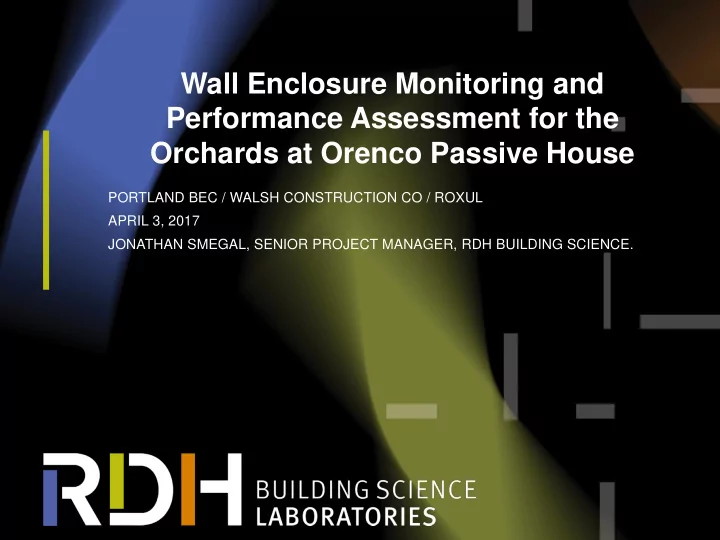

Wall Enclosure Monitoring and Performance Assessment for the Orchards at Orenco Passive House PORTLAND BEC / WALSH CONSTRUCTION CO / ROXUL APRIL 3, 2017 JONATHAN SMEGAL, SENIOR PROJECT MANAGER, RDH BUILDING SCIENCE.
Orchards at Orenco • Moisture Monitoring System • Data Analysis Graphs • Exterior Insulation • Comparison of two different High-R wall assemblies 2
3
4
(Roxul Comfortboard 80) Smegal Jonathan and John Straube. “Hygrothermal Analysis of Exterior Rockwool Insulation.” December 2011. Building Science Corporation. RR-1104. www.buildingscience.com/documents/reports/rr-1104-hygrothermal-analysis- exterior-rockwool-insulation 5
Stud Cavity Instrumentation • In all four suites • “Guard bay” on each side of measurement bay • Sensors at different heights in the cavity 6
Relative Humidity • With a temperature sensor • Vapor permeable water proof protective cover • Two locations against sheathing • Two locations at mid depth 7
Moisture content • Metal pins • Tip measurement • Electrical resistance correlates to wood moisture content • With a temperature sensor • Three locations on sheathing, one on framing 8
Exterior Sensors • Relative humidity sensors on the interior and exterior surface of the exterior insulation • *Some redundancy as a backup* • A lot of care taken at penetrations 9
Exterior RH - Interior and exterior surface of Roxul 10
11
12
Boundary Conditions • Interior Conditions – Measured at HRV return – Hobos • Exterior Conditions – Local weather station data 13
Data Analysis 14
Performance Evaluation Criteria • Sheathing moisture content – highest likelihood of moisture accumulation in colder climates • Relative humidity at the sheathing – keep in mind duration, temperature • Sheathing dew point – compare interior dew point to sheathing temperature • Mold Index • Start by looking at the interior boundary conditions since they significantly influence the wall performance 15
Interior Conditions - temp 16
Interior Conditions - RH 17
Sheathing moisture content 18
Sheathing relative humidity - North 19
Sheathing temperature - North 20
Sheathing relative humidity - South 21
Sheathing Dew Point • Compare the dew point of the interior suite air to sheathing temperature. • This does not mean there’s condensation occurring, just possible – Relative Risk • Important to consider length of time less than dew point, and the magnitude of the difference • Comparisons of a previous study 22
Sheathing Dew Point Hours of potential condensation - North Suites 520, 411 23 - South Suites 268, 267 over two years
Sheathing Dew Point Comparison 24
(5 months – 3912 hours) Smegal, Jonathan, Joseph Lstiburek, John Straube, and Aaron Grin. “Moisture -Related Durability of Walls with Exterior Insulation in the Pacific Northwest.” Paper presented at Thermal Performance of the Exterior Envelopes of Whole Buildings XII International Conference, Clearwater, FL, December 2013. 25 http://www.buildingsciencelabs.com/wp-content/uploads/2014/11/Clearwater-2013-Smegal.pdf
Mold Index • Some research conducted shows ASHRAE 160 correlates poorly to biological growth. • The Finnish VTT has been shown to provide a greater degree of reliability. • All suites in Orchards are 0 on the index 26
Exterior Insulation (CI) 27
Advantages of CI • Continuous – Significantly reduces thermal bridging (increases effective R-value) • Energy benefits • Comfort benefits • Exterior – Increases temperature of the condensation plane – Durability benefits, reduced risk of moisture condensation and accumulation
Assumes no floor slabs, no double studs etc. Best-case R-values for stud walls www.BuildingSci ence.com
• “Perfect” or “Ideal Wall” • Must consider cost, constructability, etc. • Compromises on insulation location
Screws Through Insulation • Rapidly gaining popularity to meet increasing R-value requirements • Uncertainty about: – How to do it – Allowable loads – Fastener types – Fastener spacing – Deflection
Extensive testing has demonstrated performance
Screws Through Insulation Highly Effective Continuous Vertical Z-Girt Continuous Horizontal Z-Girt Aluminum T-Clip Intermittent Galvanized Clip Stainless Steel Clip Isolated Galvanized Clip Fiberglass Clip Galv. Screws Galvanized Steel Screws Galvanized Screws Fiberglass Clip SS Screws Stainless Steel Screws Stainless Steel Screws Fiberglass Clip No Through Screws 0% 10% 20% 30% 40% 50% 60% 70% 80% 90%100% Percent Effectiveness of Exterior Insulation (Typical Range)
Comparison of two different High-R wall assemblies 34
Enclosure Performance Comparison • Two Passive House projects – Victoria, British Columbia – Portland, Oregon • Very similar temperatures (HDD) • Both High-R wall assemblies – Different strategies – Both have moisture monitoring installed *Smegal , Jonathan, Robert Lepage, and Chris Schumacher. “Moisture -Related Durability of InService High- R Wall Assemblies in Pacific Northwest Climates.” Paper presented at Thermal Performance of the Exterior Envelopes of Whole Buildings XIII International Conference, Clearwater, FL, December 2016. 35
36
(Roxul Comfortboard 80) 37
Evaluation Criteria • Challenge of comparing the performance of two different buildings in different cities – Show the relationship between exterior temperature and sheathing temperature – Mold Index 38
39
40
Conclusions • From the analysis of measurement data, there is no indication of any moisture related durability risks in the enclosure at the Orchards Passive House. • Using continuous exterior insulation has both energy and durability related benefits that reduce the risk of moisture issues in the enclosure compared to a similar wall without exterior insulation 41
Acknowledgements • ROXUL Energy Design Center for funding the research • Walsh Construction Co. for providing a building to monitor, and helping ensure the installation went as smoothly as possible
Contact me at: jsmegal@rdh.com LAB Events (Learning About Building Science) are webcast live from the RDH Building Science Laboratories facility in Waterloo, Ontario. Our goal is to take high-quality research and building science principles and make them fun! Find out more at learnbuildingscience.com
Recommend
More recommend